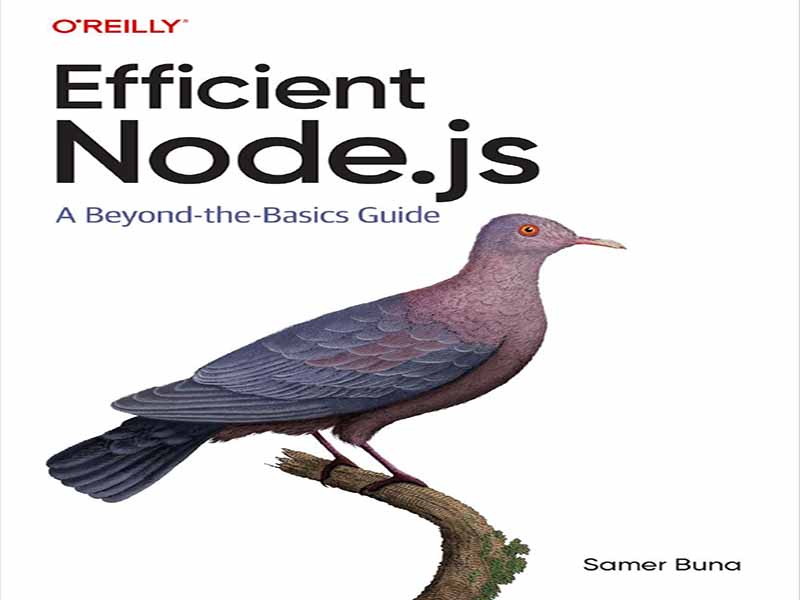- عنوان کتاب: Efficient Node.js
- نویسنده: Samer Buna
- حوزه: Node.js
- سال انتشار: 2025
- تعداد صفحه: 439
- زبان اصلی: انگلیسی
- نوع فایل: pdf
- حجم فایل: 8.21 مگابایت
این کتاب تلاش من برای کمک به یادگیری موثر Node.js است. این به طور طبیعی در چند مفهوم جاوا اسکریپت فرو می رود، اما به طور کلی، شما نیاز به درک اولیه خوبی از زبان جاوا اسکریپت دارید تا بیشترین ارزش را از این کتاب ببرید. اگر کار با اشیاء، توابع، عملگرها و تکرارکننده های جاوا اسکریپت راحت نیستید، خواندن یک کتاب مقدماتی در مورد جاوا اسکریپت قبل از این کتاب کمک کننده خواهد بود. این کتابی است که وقتی شروع به یادگیری Node.js کردم آرزو داشتم وجود داشته باشد. در آن زمان، من عمدتاً روی قسمت جلویی تمرکز داشتم. طبیعتاً، این کتاب برای توسعهدهندگانی که میخواهند تجربه خود را به نسخههای باطنی گسترش دهند، مناسب است. وقتی صحبت از یادگیری Node.js می شود، بسیاری از آموزش ها، کتاب ها و دوره ها به جای خود محیط زمان اجرا Node.js، بر روی کتابخانه ها و ابزارهای موجود در اکوسیستم Node.js تمرکز دارند. آنها آموزش نحوه استفاده از کتابخانه ها و چارچوب های محبوب Node.js را به جای شروع از قابلیت های بومی Node.js در اولویت قرار می دهند. این رویکرد قابل درک است زیرا Node.js یک محیط زمان اجرا سطح پایین است. راهحلهای جامع ارائه نمیکند، بلکه مجموعهای از ماژولهای ضروری کوچک است که ایجاد راهحلها را آسانتر و سریعتر میکند. به عنوان مثال، یک وب سرور تمام عیار گزینه هایی مانند ارائه فایل های ثابت (مانند تصاویر، فایل های CSS و غیره) خواهد داشت. با ماژول http داخلی Node.js می توانید یک وب سرور بسازید که داده های باینری را ارائه می دهد و با ماژول fs داخلی Node.js می توانید محتویات یک فایل را از سیستم فایل بخوانید. می توانید با استفاده از کد جاوا اسکریپت خود، هر دوی این ویژگی ها را برای ارائه دارایی های ثابت ترکیب کنید. هیچ روش داخلی Node.js برای ارائه داراییهای استاتیک تحت وب سرور وجود ندارد. کتابخانههای محبوب Node.js که بخشی از خود Node.js نیستند (مانند Express.js، Next.js و بسیاری دیگر با .js در نام خود) هدفشان ارائه راهحلهای تقریباً کامل در دامنههای خاص است. به عنوان مثال، Express.js در ایجاد و اجرای یک وب سرور (و ارائه دارایی های ثابت و بسیاری از ویژگی های منظم دیگر) تخصص دارد. در عمل، بیشتر توسعهدهندگان به تنهایی از Node.js استفاده نمیکنند، بنابراین منطقی است که مواد آموزشی بر روی کتابخانههایی تمرکز کنند که راهحلهای جامع ارائه میدهند، بنابراین زبانآموزان میتوانند به بخشهای خوب بپردازند. تفکر رایج در اینجا این است که فقط توسعه دهندگانی که کارشان نوشتن این کتابخانه ها است باید لایه پایه زیرین Node.js را درک کنند. با این حال، من استدلال میکنم که درک کاملی از قدرت داخلی Node.js قبل از استفاده از هر یک از کتابخانهها و ابزارهای خارجی آن ضروری است. داشتن درک عمیق از Node.js به توسعهدهندگان این امکان را میدهد که هنگام انتخاب کتابخانهها و نحوه استفاده مؤثر از آنها تصمیم بگیرند. این کتاب تلاش من برای اولویتبندی ابتدا یادگیری قابلیتهای بومی Node.js و سپس استفاده از آن دانش برای استفاده مؤثر از کتابخانهها و ابزارهای قدرتمند در اکوسیستم آن است.
This book is my attempt at helping you learn Node.js efficiently. It naturally dips into a few JavaScript concepts, but in general, you need a good basic understanding of the JavaScript language to get the most value out of this book. If you’re not comfortable working with JavaScript objects, functions, operators, and iterators, reading an introductory book about JavaScript before this book would help. This is the book that I wished existed when I started learning Node.js. At that time, I was mainly focusing on the frontend. Naturally, this book is a good fit for a frontend developer wanting to expand their experience to the backend. When it comes to learning Node.js, many tutorials, books, and courses tend to focus on the libraries and tools available within the Node.js ecosystem, rather than the Node.js runtime environment itself. They prioritize teaching how to utilize popular Node.js libraries and frameworks, instead of starting from the native capabilities of Node.js. This approach is understandable because Node.js is a low-level runtime environment. It does not offer comprehensive solutions but rather a collection of small essential modules that makes creating solutions easier and faster. For example, a full-fledged web server will have options like serving static files (like images, CSS files, etc.). With the Node.js built-in http module, you can build a web server that serves binary data, and with the Node.js built-in fs module, you can read the content of a file from the filesystem. You can combine both of these features to serve static assets by using your own JavaScript code. There’s no built-in Node.js way to serve static assets under a web server. Popular Node.js libraries that are not part of Node.js itself (such as Express.js, Next.js, and many others with .js in their names) aim to provide nearly complete solutions within specific domains. For example, Express.js specializes in creating and running a web server (and serving static assets, and many other neat features). Practically, most developers will not be using Node.js on its own, so it makes sense for educational materials to focus on the libraries offering comprehensive solutions, so learners can skip to the good parts. The common thinking here is that only developers whose job is to write these libraries need to understand the underlying base layer of Node.js. However, I would argue that a solid understanding of the built-in power of Node.js is essential before utilizing any of its external libraries and tools. Having a deep understanding of Node.js allows developers to make informed decisions when choosing which libraries to use and how to use them effectively. This book is my attempt to prioritize first learning the native capabilities of Node.js and then using that knowledge to efficiently utilize the powerful libraries and tools in its ecosystem.
این کتاب را میتوانید از لینک زیر بصورت رایگان دانلود کنید:
Download: Efficient Node.js




































نظرات کاربران